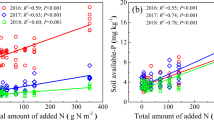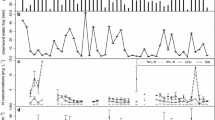Abstract
Reactive nitrogen (N) and ozone (O3) are the most widespread atmospheric pollutants with significant implications for conservation of semi-natural vegetation; their combined effects have, however, not been tested in long-term field experiments. To investigate these effects on the species composition of a subalpine Geo-Montani-Nardetum pasture, 180 turf monoliths were exposed for seven years to five N loads (0, +5, +10, +25, +50 kg N ha−1 y−1) in combination with three O3 levels (ambient, 1.2 or 1.6× ambient concentration) in a free-air fumigation experiment at 2000 m a.s.l. in the Central Alps. Aboveground biomass of grasses, forbs, sedges, and legumes, as well as individual species abundance was recorded annually. N addition caused strong changes in community composition and slightly reduced Shannon diversity: Sedges (Carex sempervirens and Carex ornithopoda) tripled their fractional biomass at the expense of legumes (Trifolium alpinum), grasses (Agrostis capillaris, Briza media, Festuca spp.), and forbs, the latter of which responded inconsistently. Compositional changes were significant with +5 kg ha−1 y−1; at all levels of N, however, changes ceased after 5 years. Elevated O3 and the combined O3 × N exposure had no effect on functional group productivity. Overall the results reveal high N sensitivity of the subalpine grassland, but low sensitivity to O3, singly or in combination with N. Thus, in the longer term any input of N above the current ambient deposition may cause a shift in the plant community composition of these ecosystems which are considered hotspots for biodiversity.





Similar content being viewed by others
References
Aerts R. 1999. Interspecific competition in natural plant communities: mechanisms, trade-offs and plant-soil feedbacks. J Exp Bot 50:29–37.
Ainsworth EA, Yendrek CR, Sitch S, Collins WJ, Emberson LD. 2012. The effects of tropospheric ozone on net primary productivity and implications for climate change. Ann Rev Plant Biol 63:637–61.
Andersen CP. 2003. Source-sink balance and carbon allocation below ground in plants exposed to ozone. New Phytol 157:213–28.
Bassin S, Schalajda J, Vogel A, Suter M. 2012. Different types of sub-alpine grassland respond similarly to elevated nitrogen deposition in terms of productivity and sedge abundance. J Veg Sci 23:1024–34.
Bassin S, Volk M, Fuhrer J. 2007a. Factors affecting the ozone sensitivity of temperate European grasslands: an overview. Environ Pollut 146:678–91.
Bassin S, Volk M, Suter M, Buchmann N, Fuhrer J. 2007b. Nitrogen deposition but not ozone affects productivity and community composition of subalpine grassland after 3 year of treatment. New Phytol 175:523–34.
Bassin S, Werner RA, Sorgel K, Volk M, Buchmann N, Fuhrer J. 2009. Effects of combined ozone and nitrogen deposition on the in situ properties of eleven key plant species of a subalpine pasture. Oecologia 158:747–56.
Blanke V, Bassin S, Volk M, Fuhrer J. 2013. Nitrogen deposition effects on subalpine grassland: role of nutrient limitations and changes in mycorrhizal abundance. Acta Oecol. doi:10.1016/j.actao.2012.09.002.
Bobbink R, Hicks K, Galloway J et al. 2010. Global assessment of nitrogen deposition effects on terrestrial plant diversity: a synthesis. Ecol Appl 20:30–59.
Bovolenta S, Spanghero M, Dovier S, Orlandi D, Clementel F. 2008. Chemical composition and net energy content of alpine pasture species during the grazing season. Animal Feed Sci Technol 146:178–91.
Bowman WD, Gartner JR, Holland K, Wiedermann M. 2006. Nitrogen critical loads for alpine vegetation and terrestrial ecosystem response: are we there yet? Ecol Appl 16:1183–93.
Burnham KP, Anderson DR. 2002. Model selection and multimodel interference: a practical-theoretical approach. Berlin: Springer.
Callaway RM, Brooker RW, Choler P et al. 2002. Positive interactions among alpine plants increase with stress. Nature 417:844–8.
Clark CM, Tilman D. 2008. Loss of plant species after chronic low-level nitrogen deposition to prairie grasslands. Nature 451:712–15.
De Schrijver A, De Frenne P, Ampoorter E, Van Nevel L, Demey A, Wuyts K, Verheyen K. 2011. Cumulative nitrogen input drives species loss in terrestrial ecosystems. Glob Ecol Biogeogr 20:803–16.
Dietl W, Jorquera M. 2003. Wiesen- und alpenpflanzen. Zurich: Agrar Verlag / FAL Reckenholz.
Duprè C, Stevens CJ, Ranke T et al. 2010. Changes in species richness and composition in European acidic grasslands over the past 70 years: the contribution of cumulative atmospheric nitrogen deposition. Glob Chang Biol 16:344–57.
Franzaring J, Tonneijck AEG, Kooijman AWN, Dueck TA. 2000. Growth responses to ozone in plant species from wetlands. Environ Exp Bot 44:39–48.
Galloway JN, Dentener FJ, Capone DG et al. 2004. Nitrogen cycles: past, present, and future. Biogeochemistry 70:153–226.
Grime JP, Hodgson JG, Hunt R. 1996. Comparative ecology: a functional approach to common British species. London: Chapmann and Hall.
Hautier Y, Niklaus PA, Hector A. 2009. Competition for light causes plant biodiversity loss after eutrophication. Science 324:636–8.
Hayes F, Jones MLM, Mills G, Ashmore M. 2007. Meta-analysis of the relative sensitivity of semi-natural vegetation species to ozone. Environ Pollut 146:754–62.
Jones MLM, Hodges G, Mills G. 2010. Nitrogen mediates above-ground effects of ozone but not below-ground effects in a rhizomatous sedge. Environ Pollut 158:559–65.
Körner C. 2003. Alpine plant life. Berlin: Springer.
Kuechler M. 2004. VEGEDAZ: Ein Programmpaket zur Erfassung und Exploration von Vegetationsdaten. http://www.wsl.ch/index_EN. WSL, Birmensdorf, Switzerland.
Landolt E. 1977. Oekologische Zeigerwerte der Schweizer Flora. Geobotanisches Institut der ETH, Stiftung Rübel, Zurich
Logan JA, Staehelin J, Megretskaia IA et al. 2012. Changes in ozone over Europe: analysis of ozone measurements from sondes, regular aircraft (MOZAIC) and alpine surface sites. J Geophys Res: Atmospheres 117:D09301.
Mills G, Hayes F, Jones MLM, Cinderby S. 2007. Identifying ozone-sensitive communities of (semi-)natural vegetation suitable for mapping exceedance of critical levels. Environ Pollut 146:736–43.
Nussbaum S, Geissmann M, Fuhrer J. 1995. Ozone exposure-response relationships for mixtures of perennial ryegrass and white clover depend on ozone exposure patterns. Atmospheric Environ 29:989–95.
Onipchenko VG, Makarov MI, Akhmetzhanova AA et al. 2012. Alpine plant functional group responses to fertiliser addition depend on abiotic regime and community composition. Plant Soil 357:103–15.
Payne RJ, Dise NB, Stevens CJ, Gowing DJ, BEGIN Partners. 2012. Impact of nitrogen deposition at the species level. PNAS. doi:10.1073/pnas.1214299109.
Pell EJ, Schlagnhaufer CD, Arteca RN. 1997. Ozone-induced oxidative stress: mechanisms of action and reaction. Physiol Plantarum 100:264–73.
Pennings SC, Clark CM, Cleland EE et al. 2005. Do individual plant species show predictable responses to nitrogen addition across multiple experiments? Oikos 110:547–55.
Phoenix GK, Booth RE, Leake JR, Read DJ, Grime JP, Lee JA. 2003. Effects of enhanced nitrogen deposition and phosphorus limitation on nitrogen budgets of semi-natural grasslands. Glob Chang Biol 9:1309–21.
Pinheiro JC, Bates DM. 1996. Unconstrained parametrizations for variance–covariance matrices. Stat Comput 6:289–96.
R Development Core Team. 2011. R: A language and environment for statistical computing. Vienna: R Foundation for Statistical Computing.
Ramo K, Kanerva T, Nikula S, Ojanpera K, Manninen S. 2006. Influences of elevated ozone and carbon dioxide in growth responses of lowland hay meadow mesocosms. Environ Pollut 144:101–11.
Remke E, Brouwer E, Kooijman AM, Blindow I, Esselink H, Roelofs JGM. 2009. Even low to medium nitrogen deposition impacts vegetation of dry, coastal dunes around the Baltic sea. Environ Pollut 157:792–800.
Sanz J, Bermejo V, Muntifering R, Gonzalez-Fernandez I, Gimeno BS, Elvira S, Alonso R. 2011. Plant phenology, growth and nutritive quality of Briza maxima: responses induced by enhanced ozone atmospheric levels and nitrogen enrichment. Environ Pollut 159:423–30.
Shane MW, Cawthray GR, Cramer MD, Kuo J, Lambers H. 2006. Specialized ‘dauciform’ roots of Cyperaceae are structurally distinct, but functionally analogous with ‘cluster’ roots. Plant Cell Environ 29:1989–99.
Shannon CE, Weaver W. 1949. The mathematical theory of communication. Urbana: University Illinois Press.
Soudzilovskaia NA, Onipchenko VG. 2005. Experimental investigation of fertilization and irrigation effects on an alpine heath, northwestern Caucasus, Russia. Arct Antarct Alp Res 37:602–10.
Soudzilovskaia NA, Onipchenko VG, Cornelissen JHC, Aerts R. 2005. Biomass production, N:P ratio and nutrient limitation in a Caucasian alpine tundra plant community. J Veg Sci 16:399–406.
Staehelin J, Thudium J, Buehler R, Volzthomas A, Graber W. 1994. Trends in surface ozone concentrations at Arosa (Switzerland). Atmospheric Environ 28:75–87.
Stampfli A. 1991. Accurate determination of vegetational change in meadows by successive point quadrat analysis. Vegetatio 96:185–94.
Stampfli A, Fuhrer J. 2010. Spatial heterogeneity confounded ozone-exposure experiment in semi-natural grassland. Oecologia 162:515–22.
Stevens CJ, Dise NB, Mountford JO, Gowing DJ. 2004. Impact of nitrogen deposition on the species richness of grasslands. Science 303:1876–9.
Stevens CJ, Maskell LC, Smart SM, Caporn SJM, Dise NB, Gowing DJG. 2009. Identifying indicators of atmospheric nitrogen deposition impacts in acid grasslands. Biol Conserv 142:2069–75.
Theodose TA, Bowman WD. 1997. Nutrient availability, plant abundance, and species diversity in two alpine tundra communities. Ecology 78:1861–72.
Thwaites RH, Ashmore MR, Morton AJ, Pakeman RJ. 2006. The effects of tropospheric ozone on the species dynamics of calcareous grassland. Environ Pollut 144:500–9.
Volk M, Geissmann M, Blatter A, Contat F, Fuhrer J. 2003. Design and performance of a free-air exposure system to study long-term effects of ozone on grasslands. Atmospheric Environ 37:1341–50.
Volk M, Obrist D, Novak K, Giger R, Bassin S, Fuhrer J. 2011. Subalpine grassland carbon dioxide fluxes indicate substantial carbon losses under increased nitrogen deposition, but not at elevated ozone concentration. Glob Chang Biol 17:366–76.
Wedlich KV, Rintoul N, Peacock S et al. 2012. Effects of ozone on species composition in an upland grassland. Oecologia 168:1137–46.
Wildi B, Lutz C. 1996. Antioxidant composition of selected high alpine plant species from different altitudes. Plant Cell Environ 19:138–46.
Wyness K, Mills G, Jones L, Barnes JD, Jones DL. 2011. Enhanced nitrogen deposition exacerbates the negative effect of increasing background ozone in Dactylis glomerata, but not Ranunculus acris. Environ Pollut 159:2493–9.
Acknowledgments
This study was supported by the Swiss Federal Office of Environment in the framework of the International Cooperative Programme (ICP Vegetation) under the UNECE CLRTAP and it contributes to the EU project ECLAIRE. The help of M. Montani, D. Al Jabaji, R. Giger, V. Blanke, J. Schalajda, U. Zell, and A.L. Wahl in performing field work and vegetation relevés is greatly acknowledged.
Author information
Authors and Affiliations
Corresponding author
Additional information
Author Contributions
SB designed study, performed research, analyzed data, wrote the article. MV designed study. JF designed study, edited article.
Electronic supplementary material
Below is the link to the electronic supplementary material.
Rights and permissions
About this article
Cite this article
Bassin, S., Volk, M. & Fuhrer, J. Species Composition of Subalpine Grassland is Sensitive to Nitrogen Deposition, but Not to Ozone, After Seven Years of Treatment. Ecosystems 16, 1105–1117 (2013). https://doi.org/10.1007/s10021-013-9670-3
Received:
Accepted:
Published:
Issue Date:
DOI: https://doi.org/10.1007/s10021-013-9670-3




